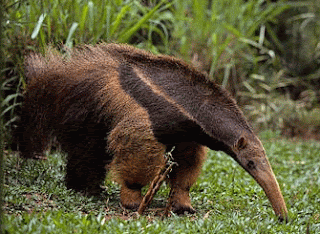It eats insects and picks its prey up by rapidly flicking its long sticky tongue in and out. Its mouth is long and tubular and does not have any teeth. Of all the anteaters, it is the largest species and can weigh up to 39 kg or 86 lbs. Its body is covered with a coarse coat with a gray stripe running down each shoulder. Its tail is long and bushy. It has long front claws which is used for defense against enemies and tearing apart termite mounds. Their claws are so long that they are tucked under its feet and the anteater walks on its knuckles.
It is a solitary animal and gives birth to only one young. It carries the young on its back for almost a year during its growth.
The Giant Anteater's numbers have depleted due to the loss of its habitat to human construction. The fact that its reproduction rate is very low does not encourage the increase of its numbers.

